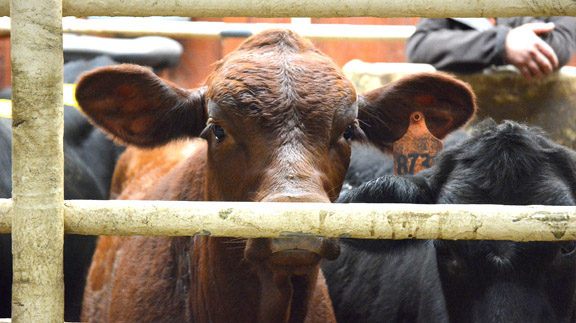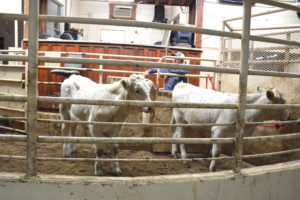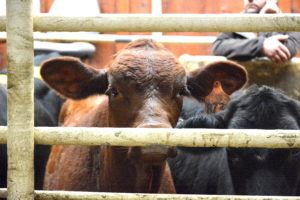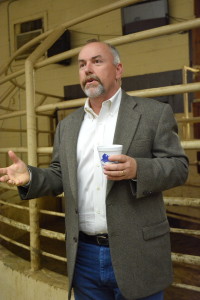Farm & Ranch
Texas crop and weather, Nov. 10, 2015

By: Blair Fannin
Cattle prices softening due to U.S. herd expansion
Writer: Blair Fannin, 979-845-2259, [email protected]
Contacts: Dr. David Anderson, 979-845-4351, [email protected]
Dr. Clark Neely, 979-862-1412, [email protected]
COLLEGE STATION – The nation’s beef cattle producers are in expansion mode and record-high cattle prices have likely seen a top, according to a Texas A&M AgriLife Extension Service livestock marketing economist.
“Over the long term, we are continuing to expand and prices are coming down from record highs because we are expanding herds,” said Dr. David Anderson, College Station. “We are starting to increase supplies and calf prices have been coming down. However, we will still see high prices since it will take some time to build our inventory back up.”
Calves continue to be sold at local auction markets across Texas as part of fall livestock activities. (Texas A&M AgriLife Extension Service photo by Blair Fannin)
Dr. Clark Neely, AgriLife Extension small grains specialist in College Station, said recent rains will help forage and wheat growth, benefiting stocker cattle operators across the state. “As of right now with all the rain we’ve had, we’ve got full soil profiles,” he said. “Right now we are just having issues with portions of Central, South Central and Eastern Texas getting the crop in the ground. The High Plains and Rolling Plains did get it in the ground in a timely manner and have an above-normal crop rating. With all the moisture we’ve had, we’ve got good grazing potential for stocker cattle operators.”
Beef demand continues to be strong and Anderson said this has helped during times of record retail prices.
“I don’t think we’d have had prices where they were if it weren’t for consumer demand,” he said. “If you put consumer demand and price together, I think that’s pretty compelling for higher prices.”
Anderson pointed to the rise in gourmet hamburger chains across the U.S.
“You have this huge growth in these specialized burger restaurants,” he said. “This coincides with one of the fewest supplies of cows in several decades. The second driver is the popularity of Texas style barbecue. We’ve seen huge growth in barbecue restaurants nationwide. This comes at a time when we’ve also got the fewest cows. Overall, this is the strongest demand for beef in 25 years.”
Beef cattle demand continues to be strong during times of record retail prices, said Dr. David Anderson, Texas A&M AgriLife Extension Service livestock marketing economist, College Station. (Texas A&M AgriLife Extension Service photo by Blair Fannin)
Looking ahead to future cattle prices, Anderson said there are currently 2 percent more cows and 2 percent more calves in the U.S. than a year ago.
“Through 2017, I’ve got every quarter of the year projected with more beef production than the year before,” he said. “I think we can continue to look for strong cattle prices and positive-side demand for beef.”
Recent declines in calf and cattle prices are largely due to record-high cattle weights resulting in more beef production, Anderson said.
“More imported beef and reduced exports are pressuring prices lower, too,” Anderson said. “But, as the fed cattle backlog is reduced, then price will rebound higher.”
Anderson said for the first quarter of 2016 he projects Southern Plains #1 500-600-pound steers at around $216 to $222 per hundredweight. Second quarter prices in 2016 are projected at $220-$227 per hundredweight, while third quarter prices are projected at $215-$224 per hundredweight. For the fourth quarter, Anderson projects prices to be $207-$216 per hundredweight.
Currently, some estimates of annual cow costs are around $700 per cow. Factoring in an average selling price of $1,100 per head for calves leaves cow-calf producers in a profitable position.
Dr. David Anderson, Texas A&M AgriLife Extension Service livestock economist, College Station. (Texas A&M AgriLife Extension Service photo by Blair Fannin)
“But, longer term, increasing cow numbers and beef production means prices are headed lower,” Anderson said.
AgriLife Extension district reporters compiled the following summaries:
SOUTH: Scattered showers continued through parts of the South Region during the past week. Most of the rainfall occurred in the northern and western parts of the region. Forage on range and pastures showed very good improvement. In the northern part of the region, peanut crops were being harvested and winter oats and wheat crops were mostly planted in the Atascosa County area. La Salle County received more rainfall during the past week, as it had the previous week, helping improve range and pastures throughout the county. Live Oak County also received rainfall of 1 to 5 inches. Range and pastures greened up well, throughout the McMullen County area, as a result of continuous rainfall, but forage growth slowed down due to cooler temperatures and shorter days. Cattle body condition scores remained in fair shape. In the eastern parts of the region, mild conditions persisted throughout the Jim Wells County area. Wheat producers were hesitant in planting wheat this year, as most had a difficult time harvesting their crops during the wet spring months. Row crop producers, on the other hand, were set for a good start on next year’s crop growing season. In the western parts of the region, wet conditions remained. Heavy rainfall fell across the Zavala County area. Cotton ginning activities were completed in two Zavala County gins. Also in Zavala County, pecan harvesting was completed, prior to the rainfall event at the end of the week, and no supplemental feeding activities took place due to good to fair grazing conditions on range and pastures. In the southern parts of the region, the Cameron County area remained saturated. Some fields have begun to dry out, but it will be a while before any field activities take place. Spring planting was halted due to fields remaining saturated throughout the area. Despite wet field, range and pasture conditions, there was plenty of good to excellent forage for livestock grazing. Also in Cameron County, corn fields were progressing well. In the Hidalgo County area, fall corn progressed, and sugarcane harvest will begin soon. Fall vegetable crops progressed well in the Starr County area.
Download or preview a two-minute MP3 version of this report
COASTAL BEND: Recent light rain added to good soil moisture conditions. Winter pasture planting was almost complete with early-season moisture providing favorable growing conditions. Some producers were top-dressing fertilizer. Low-lying areas of the Guadalupe River flooded and caused problems with some of the pecan harvest. Cattle continued to be in good condition with calves weaned and sold at local auction markets.
SOUTHWEST: Adequate moisture was received throughout much of the area as a result of recent rains. Winter pastures have benefitted from rainfall and range conditions were showing signs of improvement. Field conditions continued to be wet after recent rainfall. Pecan harvest has slowed due to wet conditions. Wheat and oats had been planted and were emerging. Planted wheat and oats were looking good with recent rains. Native winter grass was in good condition as a result of rainfall. In many cases, fields were still too wet to get into because of recent heavy rains.
SOUTHEAST: In Walker County, the rain has helped the past two weeks. Cool-season forages, small grains and legumes, had germinated and began to grow. Wet field conditions in Brazos County prevented many cotton farmers from completely destroying harvested fields. Volunteer cool-season annual grasses were emerging. Grimes County had another weekend full of rain and high winds. All standing water has subsided. Fields were stable enough to drive a tractor on and hay was being baled. In Montgomery County, recent rainfall allowed producers to become involved with winter annual planting. Temperatures were still above average, which promoted Bermudagrass growth recovery. Fort Bend County recently received more than 9 inches of rain. Some cattle producers have planted ryegrass for winter forage. Livestock were in good condition.
SOUTH PLAINS: In Floyd County, warm dry days have helped harvest activities. Nearly all corn and milo harvest was complete. Cotton was the main focus now and was progressing nicely. Heavy dew or moisture the past three weeks has caused Swisher County farmers to stop harvest and wait for drier conditions. Pasture and range were in good condition with light supplementing reported. The wheat crop was excellent and stocker cattle were moving onto wheat at a steady pace. A bumper year for haygrazer was expected, but sugarcane aphid colonization in these fields has drastically lowered the protein content making a surplus of fair condition hay available in the $45 to $50 price range per round bale. Bailey County producers had several mornings with light frost and one morning low of 22 degrees. Harvest continued for all crops. In Cochran County, soil moisture levels were in good condition. Peanut and corn harvests were finished. Cotton, sunflower and sorghum harvest was ongoing. Pasture, range and winter wheat were all in good condition. Lubbock County received frost in low areas with one morning low of 33 degrees. A freeze is needed to condition remaining crops for harvest. Cotton harvest reached the halfway point, with harvest furthest along in the Slaton area. In Garza County, cotton harvest resumed after rainfall with approximately 20 to 25 percent of the crop harvested. Yields were coming in a little better than expected due to warm weather late in the growing season that allowed the late crop to mature. Range and pastures should improve over the next few days due to rainfall on cool-season grasses. However, some locations were limited due to weed pressure. Cattle were in good to excellent condition with no supplemental feeding being reported. Scurry County had mild weather last week and received no rain. Cotton harvest will resume once producers can get back in the fields.
ROLLING PLAINS: Fall-like weather prevailed over the past several weeks in the Rolling Plains. Thus far, there has been no early freeze/frost, which could be beneficial for cotton producers, especially in fields that were planted late. Early planted fields have been defoliated and producers were beginning to harvest. This year’s cotton crop was variable with some fields very poor, while others were in excellent condition. With cotton prices very low compared to previous years, producers were looking to cut costs and were defoliating fewer acres than in the past. Some producers were opting to wait for a freeze. Over the past few weeks moisture was recorded and has helped rangeland and pastures. Wild ryegrass has flourished. This has helped ranchers save money on supplemental feeding costs. Winter wheat was looking better as producers have finished planting fields and have just enough moisture to hopefully get the wheat up and going in a reasonable amount of time. Grazing may be limited due to late planting. Range and pastures were in good condition as were livestock.
CENTRAL: Continued rainfall has caused erosion, leaving producers out of the fields due to soggy conditions. Washed out bridges prevented transfer of equipment. Oats already planted have emerged; wheat was up in some places with some being flooded or held back and stunted due to the extreme wetness. Cotton growers lacked dry days to harvest their crop. Growing conditions were good for small grains. Cooler temperatures have arrived. All counties in the region were reporting soil moisture as good, while overall range and pasture conditions were rated at 95 percent. Overall crop conditions stood at 85 percent and overall livestock conditions in the region were rated at 95 percent.
FAR WEST: Cooler, fall-like temperatures were reported district-wide with producers awaiting the first frost. Livestock producers were finishing fall work with calf weaning weights reported on the heavy side. Pregnancy rates on heifers and mature cows were all very good. Overall condition of cattle good. Clean-up bucks have been put out to finish the breeding season. Cotton harvest was in full swing with average yields and good lint quality. Fall planted onions had emerged and were at the two-leaf stage. Pecan shucks were opening, but needed the first frost to assist in defoliation. Pastures and rangeland were in good condition.
EAST: More rain was received across the region causing conditions to go from extremely dry to extremely wet. Fields remained saturated. Most counties reported subsoil and topsoil moisture levels adequate or surplus. The rain caused some decline in vegetable crops. Lakes and ponds were overflowing. Damage assessment continued from flooding in Henderson County. Anderson County reported a tornado in a lightly populated area of the county, which caused minimal damage to trees and fences. The Trinity River was out of its banks in many places. Winter pastures were coming up for those who planted before the rain. Rain came too late for summer pastures to produce, which led to many producers feeding grain and hay to livestock. Cattle remained in fair to good condition. Market sales has slowed due to the inability to gather cattle. The cattle market showed steady to slightly higher prices on calves and slaughter cattle. Feral hogs were moving and causing damage.
WEST CENTRAL: Days were warm with cool nights. Scattered showers were reported in most areas. Recent rains improved soil moisture and helped decrease chances of wildfires. Cotton harvest was delayed due to wet conditions, but will be back in full swing as conditions allow. There was some concern regarding lint quality due to weather conditions. Early planted winter wheat has emerged and was in good to excellent condition. Wheat planting will resume as soon as fields are dry enough to start sowing. More wheat will be planted as cotton comes out and conditions allow. Sesame harvest was underway. Range and pasture conditions improved with recent rains. Winter pastures were coming along and should provide good forage soon. Lots of cool-season annuals were emerging in pastures, including Texas wintergrass. Livestock were in fair to good condition. Supplemental feeding was underway. Cattle prices have moderated somewhat. Sheep and goat markets continues to be strong. Early variety pecans were harvested.
NORTH: Topsoil moisture varied from adequate to surplus. Rainfall amounts have varied across the county from 1 to 3 inches. Nighttime temperatures were cooling off. Rains were beneficial for newly planted small grains and winter annual pastures. Warm-season grass production was coming to a close. Cool-season grasses were starting to grow. Many small grain farmers were still waiting to plant. Hay supplies seemed to be adequate, but the quality overall was not as good as usual. Wheat struggled due to weather patterns. Ponds were filling. Livestock were stressing as temperatures fluctuated. Feral hog activity increased.
PANHANDLE: Texas Panhandle temperatures were near normal. Moisture was received in the north and northeastern counties. Amounts ranged from a trace to 1.5 inches. Soil moisture was rated adequate. Peanut yields have been average to below average. Sorghum was nearly all out of the fields. Cotton harvest was almost halfway complete and yields appeared to be average to above average. Deaf Smith County producers were running combines in corn and grain sorghum fields. Corn harvest was starting to wind down with a good week of harvest activity. Dryland grain sorghum was lodging. Recent winds caused lodging to become more of a problem. Sprouting of grain in the head was also a concern. Winter wheat was being planted in many fields where corn was harvested. Wheat in general looked good and many early planted fields were starting to be grazed. Hall County wheat and pasture conditions improved due to rains. Cotton harvest slowed because of rains and wet mornings. Cattle conditions continued to improve. Rain and wind in Hansford County slowed harvest. Some fields of corn and milo were starting to lodge from rain and wind.
-30-
Find more stories, photos, videos and audio at http://today.agrilife.org
Farm & Ranch
Acorn Toxicity

By Barry Whitworth, DVM, MPH
With the prolonged drought, most pastures in Oklahoma end up in poor condition. With the lack of available forage, animals may go in search of alternative foods.
If oak trees are in the pastures, acorns may be a favorite meal for some livestock in the fall. This may result in oak poisoning.
Oak leaves, twigs, buds, and acorns may be toxic to some animals when consumed.
To read more, pick up a copy of the November edition of North Texas Farm & Ranch magazine, available digitally and in print. To subscribe by mail, call 940-872-5922.

Farm & Ranch
Silver Bluestems

By: Tony Dean
There are a handful of grasses on North Texas grazing lands ranchers need to know, not because they are highly desirable, but rather because they are not of much value. I call them “decom” plants, which is am acronym for “Don’t Ever Count On Me.” Silver bluestem is a “decom” grass.
Silver bluestem is a perennial which grows in all areas of Texas. It can survive in almost all soil types, and in full sun conditions or in semi shade. It grows up to three feet tall and is easily recognized with the presence of the white fuzzy seed head. Also, one of the identifying characteristics of Silver bluestem is a bend in the stems at each node, causing the plants to take on a rounded shape as they mature.
To read more, pick up a copy of the November edition of North Texas Farm & Ranch magazine, available digitally and in print. To subscribe by mail, call 940-872-5922.

Farm & Ranch
Meanwhile Back At The Ranch

By: Rayford Pullen
Fall is here which means winter is closing in on us and before we officially get into winter, we need to make sure our factories are either producing or will be producing in a few months.
We have been pregnancy testing our cows this fall and if they are not bred or nursing a calf, we are bidding them adios. With annual costs somewhere between $900.00 and $1,000.00 per cow, those cows not producing a live weaned calf are costing us quite a bit.
To read more, pick up a copy of the November edition of North Texas Farm & Ranch magazine, available digitally and in print. To subscribe by mail, call 940-872-5922.
-

 Country Lifestyles2 years ago
Country Lifestyles2 years agoScott & Stacey Schumacher: A Growth Mindset
-

 Country Lifestyles8 years ago
Country Lifestyles8 years agoStyle Your Profile – What your style cowboy hat says about you and new trends in 2017
-

 HOME8 years ago
HOME8 years agoGrazing North Texas – Wilman Lovegrass
-

 Equine1 year ago
Equine1 year agoThe Will to Win
-

 Country Lifestyles5 years ago
Country Lifestyles5 years agoAmber Crawford, Breakaway Roper
-

 Outdoor9 years ago
Outdoor9 years agoButtercup or Primrose?
-

 Country Lifestyles8 years ago
Country Lifestyles8 years agoJune 2016 Profile – The man behind the mic: Bob Tallman
-

 Country Lifestyles8 years ago
Country Lifestyles8 years agoDecember 2016 Profile, Rusty Riddle – The Riddle Way







